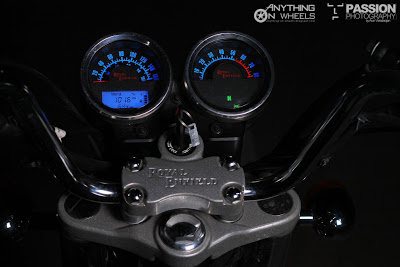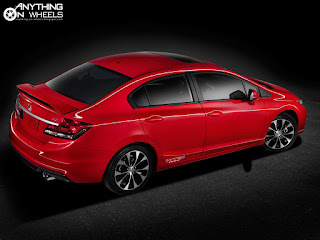Royal Enfield continues to enjoy an enviable situation in the Indian automotive market. With an image that rivals the best of international brands, every new launch from Royal Enfield creates a flutter that is quite unimaginable. Needless to say then, every model in the company's portfolio comes with waiting lists that extends to as much as six months for some models. The new Thunderbird is the latest sensation to hit the market from the Chennai-based manufacturer.
Ever since it's unveiling at the 2012 Auto Expo in New Delhi, the new Thunderbird 500 has been creating ripples across the biking community. After what can be termed an agonizing wait for the fans, the Thunderbird 500 was finally launched last month. Along with it, the existing Thunderbird 350 was also given a facelift. Will the new Thunderbird twins carry the brand's legacy forward? Will they hit the bull's eye yet again? With these questions in our mind, we rode the new Thunderbird 500 to find out. Read on.
TO LOOK AT:


Without an iota of doubt, Royal Enfield has got to have one of the best-looking portfolio of motorcycles in the Indian market today. All its models, with the lone exception of Thunderbird, follows the same 'classic retro' theme and end up looking great. The Thunderbird, being the company's first cruiser, marked a departure from that trend and came with a relatively-modern design that was equally impressive nonetheless. Now, ten years and legions of customers and fan-following later, the Thunderbird has got its first major facelift.
The basic shape and proportions of the old Thunderbird have been carried over and the new model is a perfect evolution of the original. As a result, it is instantly recognizable as a Thunderbird and will not be mistaken for anything else. What is different though are the modern touches thrown into the mix to inject the Thunderbird with a dose of modernity. The projector headlamp with LED ring, the muscular fuel tank, the three-dimensional badges and the streaks of 5 Light Emitting Diodes that make up the taillight are the elements that stand out at first sight. They not only look great and work well, but also lends a premium touch and feel to the Thunderbird. While the profile has been left untouched, the shape of the seats has changed.


Knowing the pulse of the market, Royal Enfield has done well to satisfy our fetish for chrome. The housings for instrument cluster, shrouds for headlight, taillight and indicators, suspension springs and exhaust pipe are all finished with the shiny stuff, which adds to the bling factor. In a perfect contrast, the engine and transmission casings are now painted black which aids visual appeal. The edges of the engine fins, that come painted in a shade of silver, is a neat little touch. Though the tear-drop shaped fuel tank is chunky, the offset fuel-filler cap looks a little weird. The superbly-shaped individual seats and the nicely-angled backrest enhances the 'cruiser' character of the Thunderbird.
It has to be mentioned here that Royal Enfield has gone crazy with the attention to detail in the new Thunderbird with even the foot-pegs getting the 'RE' branding.
TO SIT ON:


Step over the new Thunderbird 500 and the first thing that you notice is the strikingly-modern instrument cluster. You will be forgiven even if you decide that this cluster doesn't belong to a Royal Enfield. Having last rode the Classic 500, the instrument cluster in the new Thunderbird, with its blue back-lighting and LCD display, is a refreshing change to the eyes.
The familiar twin circular pods are carried over, with the left pod housing the speedometer, digital odometer and twin trip meters and the right pod housing the tachometer and other tell-tale lights. For the first time in a Royal Enfield, the new Thunderbird comes with features such as twin trip meters with provision for displaying the average fuel-efficiency of each trip and a service due warning. The speedometer is calibrated in, surprisingly, miles per hour too. While all this is great, the instrument cluster wasn't clearly visible in bright sunlight which proved to be a constant distraction while riding. Again, for what is a first for Royal Enfield, hazard lights are available as standard, a feature that will come to the fore on those highway rides. Quality of instruments and switches have improved significantly with only the tiny black buttons for hazard lights, mode selection and reset looking flimsy. The 'engine kill' switch that is chunky and finished in a bright red colour, is especially attractive.
Though the front seat is scooped up and has enough width to accommodate even the biggest of riders, the angle in which the seat is shaped does make us feel strained. The pillion rider's seat, in contrast, lack width but compensates with a backrest that is perfectly angled and adds to the riding comfort. In line with the 'cruiser' theme, the handlebars are high set and the seating posture is particularly comfy. The pedals for resting the foot are nicely positioned too. If not for the harsh vibrations that filter through to your body when the engine is in full blast, the Thunderbird 500 would have been exceptional.
TO RIDE:

The new Thunderbird comes in both 350 and 500cc versions, with the latter being a new addition to the Thunderbird family. The engine though isn't new. It's the same 499cc, single-cylinder, air-cooled, 4-stroke unit that powers the Classic 500 and belts out a maximum power of 27.2 bhp and a peak torque of 4.17 kgm. Turn the ignition on and the trademark 'bullet' thumps fill the air. Start moving, continue turning the throttle and rev hard until you touch the 5500 rpm redline. That's when the exhaust note gets ballistic and addictive.



When we rode the Classic 500, we were amazed by this engine's excellent low and mid-range. It is no different in the Thunderbird 500. In fact, we felt it a tad better than the Classic 500 when it comes to urban driveability. Its so good that you will be able to move forward from standstill in second gear or amble along in third gear at 20 km/h. Just a flick of the throttle and the Thunderbird 500 responds with abundant power and torque in all gears. This makes it an extremely comfortable motorcycle to ride both inside the city and out on an open highway. Though the indicated top speed is 130 km/h, the Thunderbird 500 feels supremely comfortable at speeds of 80 to 90 km/h when all the moving parts seem to be in perfect harmony with each other. The gear ratios are well placed but the gears shift with a typically-noisy clunk that has now become a characteristic of Royal Enfield motorcycles.

The Thunderbird 500 is equipped with telescopic forks up front and dual gas-charged shocks at the rear, as a result of which the ride is plush even over broken stretches of tarmac. Similar to the old Thunderbird, straight line stability is excellent and the Thunderbird 500 stays firmly planted on the road even at triple digit speeds. What's more impressive though is the way in which the Thunderbird 500 approaches corners in an agile, composed and predictable manner. Yes, the Thunderbird is still incredibly heavy, but it is now more agile and effortless to maneuver with the tyres providing good levels of grip. With a kerb weight of 195 kg, we didn't expect that to be honest. Despite possessing disc brakes in both front and rear wheels, braking continues to be a sore point. The brakes lack bite and the Thunderbird doesn't lose speeds as quickly as expected.
Coming to the most important criteria in the Indian context, the Thunderbird 500 ran 28 kilometers to a liter of gasoline, which is not bad considering the power on tap from the 500 cc engine and the weight that it needs to haul along.
SPECIFICATIONS:

* Engine Type: 4-Stroke, Air-cooled
* No of Cylinders: 1
* Displacement: 499 cc
* Maximum Power: 27.2 bhp @ 5250 rpm
* Maximum Torque: 41.3 Nm @ 4000 rpm
* Transmission Type: 5-Speed, Constant Mesh
* Tires: 90/90 R19 (Front), 120/80 R18 (Rear)
* Brakes: 280mm Disc (Front), 240mm Disc (Rear)
WE VOTE FOR:
* Modern yet classic styling
* Long list of features
* Excellent cruising ability
* Relatively better handling
WE VOTE AGAINST:
* Pricing (500cc variant)
* Inadequate braking capability
TO SUM UP:

There is no denying the fact that the Thunderbird 500 is a feather in the cap of Royal Enfield. With good looks, advanced technologies, great list of features, plush ride and excellent cruising ability, the Thunderbird 500 is what most avid bikers in India were eagerly waiting for. But, at a price of INR 182,571 on-road Mumbai, it doesn't come cheap. It's reliability with all the modern gadgetry isn't proven yet and its brakes might scare you till you get used to it. But overlook these facts and you will understand that there is absolutely nothing else on sale like the Thunderbird 500. It's for this reason we think the new Thunderbird 500 will be a huge success. If the price bothers you, go get yourself the Thunderbird 350. It gets everything that the 500 has, sans the engine.









































